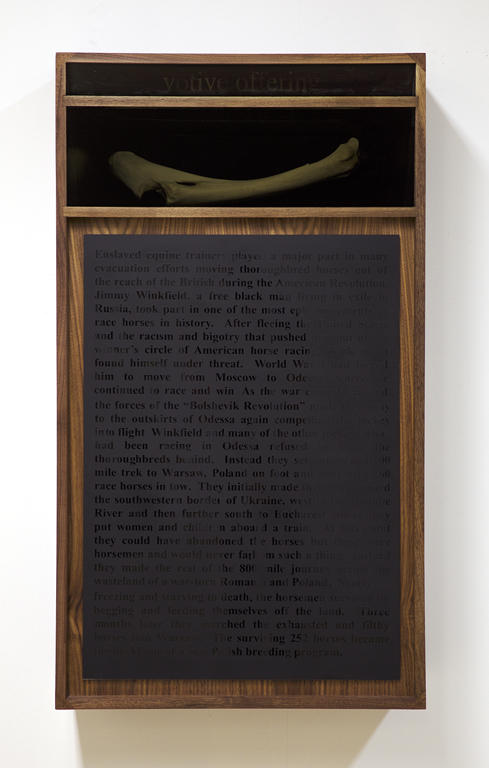
Votive Offering, 2019
Walnut, horse bone, Plexiglas, gold leaf, spray paint, and LED bulb
39 1/2 × 22 × 9 in. (100.33 × 55.88 × 22.86 cm)
Purchase, with funds from African American Art Alliance in honor of its thirtieth anniversary M2020.2
Photo credit: Courtesy of the artist and Monique Meloche Gallery, Chicago.
© Nate Young
Objective:
Students will express personal or family storytelling with a symbolic object, thoughtful writing and arrange an installation sculpture inspired by the work of contemporary artist Nate Young.
Materials:
- Scrap paper or sketchbook for planning and practice
- Variety of boxes and additional cardboard
- Dark watercolor or construction papers
- Paint or assorted papers to cover the box
- Markers for writing or printed stories on color paper
- A personal, symbolic found object, printed photo, or drawing provided by the student
Introduce:
Show students images of Nate Young’s artwork, Votive Offering and encourage them to share observations and evidence of storytelling using some of the questions below.
Contemporary, Chicago-based artist Nate Young investigates family history and how material objects can hold a sense of significance and symbolism of personal values and storytelling. From drawing and printmaking to writing and woodworking, Young composes installation sculptures that invite the viewer to explore the meaning of the works while considering how their own beliefs may influence their perceptions. In the Votive Offering, the artist is piecing together the story of his great-grandfather’s journey by horseback from the South to the North during the Great Migration. The sculpture contains a horse bone, which appears as a hologram at the top of the work. The bone itself is obscured within the sculpture alluding to themes of memory and protection while questioning how histories are made.
Hear more from the artist: Expert Series: Artist Nate Young Nate Young: The Transcendence of Time,
Ask:
- What kinds of symbols do you see in this artwork?
- What elements of storytelling do you see in this work by artist Nate Young?
- Why do you think the artist used black text on a black background?
- How does the title, Votive Offering, influence your interpretation of the artwork?
- Can you think of an object or a story that represents yourself or your family?
Activity:
- Invite students to think of an object or item that represents a personal or familial story. Consider interviewing family members to gather ideas and stories.
- Write a story about the object and how it connects to you or to your family. The story can be embellished or details can be added with artistic license.
- Sketch several compositions of how the story and object could be displayed in a box. Encourage students to experiment with materials to create the finished sculptural object. Think about colors that will complement the intention, mood, or visibility of the story within the box or object.
- Plan a critique session with a partner or small group, allowing students to share as much or as little as they feel comfortable with among peers.
- Allow appropriate time to work on the writing and creation of the finished object.
- Encourage students to decide how and where their work can be displayed. Consider grouping works by theme or similarities and students to collaborate on exhibition narratives to inform the viewer about their work and choices for display.
National Standards:
- VA:Cr2.3.8a Select, organize, and design images and words to make visually clear and compelling presentations.
- VA:Re.7.1.8a Explain how a person’s aesthetic choices are influenced by culture and environment and impact the visual image that one conveys to others
- VA:Cr3.1.Ia Apply relevant criteria from traditional and contemporary cultural contexts to examine, reflect on, and plan revisions for works of art and design in progress.
- VA:Pr5.1.8a Collaboratively prepare and present selected theme-based artwork for display, and formulate exhibition narratives for the viewer.
- VA:Cn11.1.Ia Describe how knowledge of culture, traditions, and history may influence personal responses to art.
Share your artwork with us on social media @milwaukeeart #MAMLearn or email pictures to teachers.mam.org. We’d love to see your creations!
